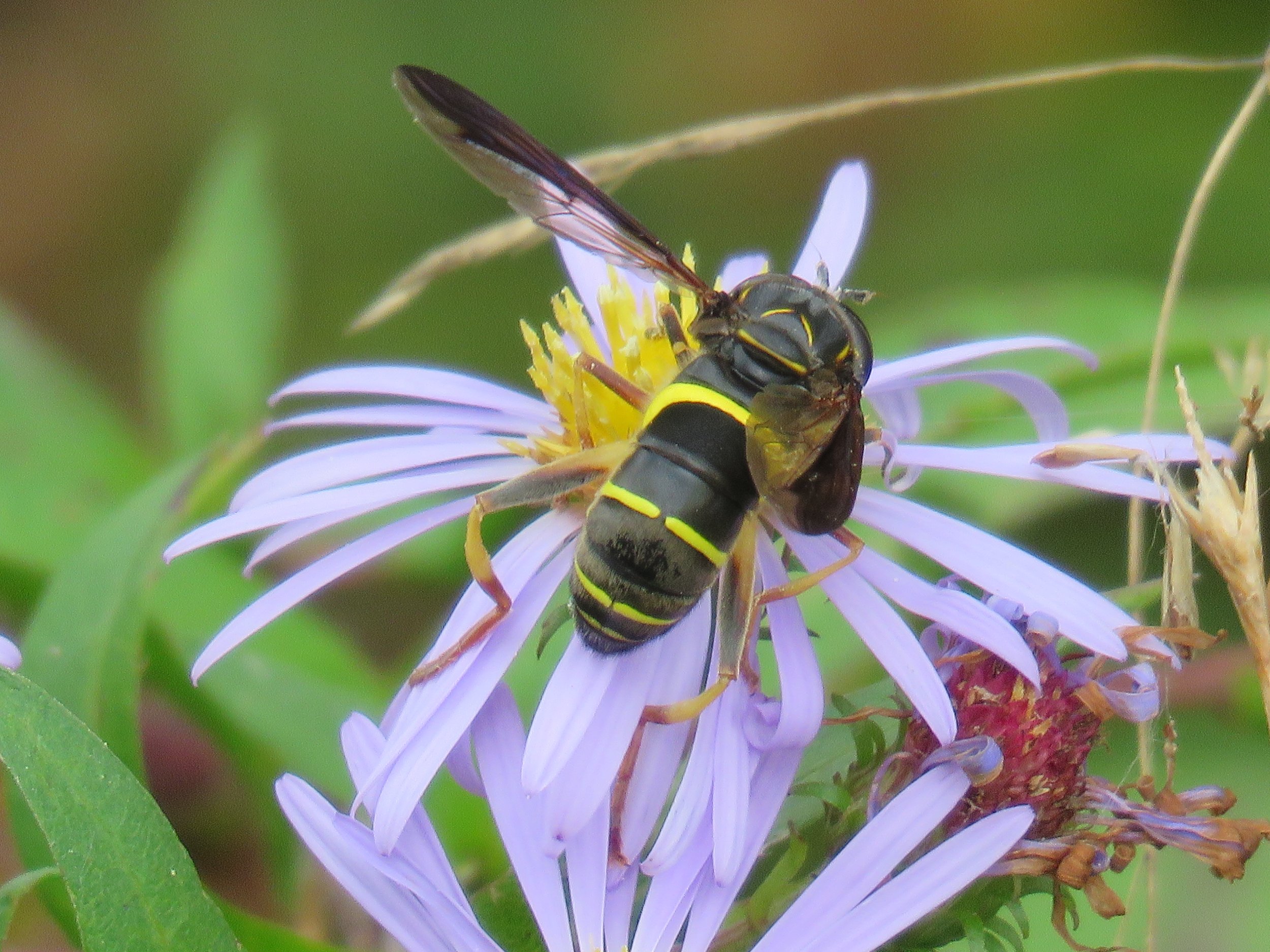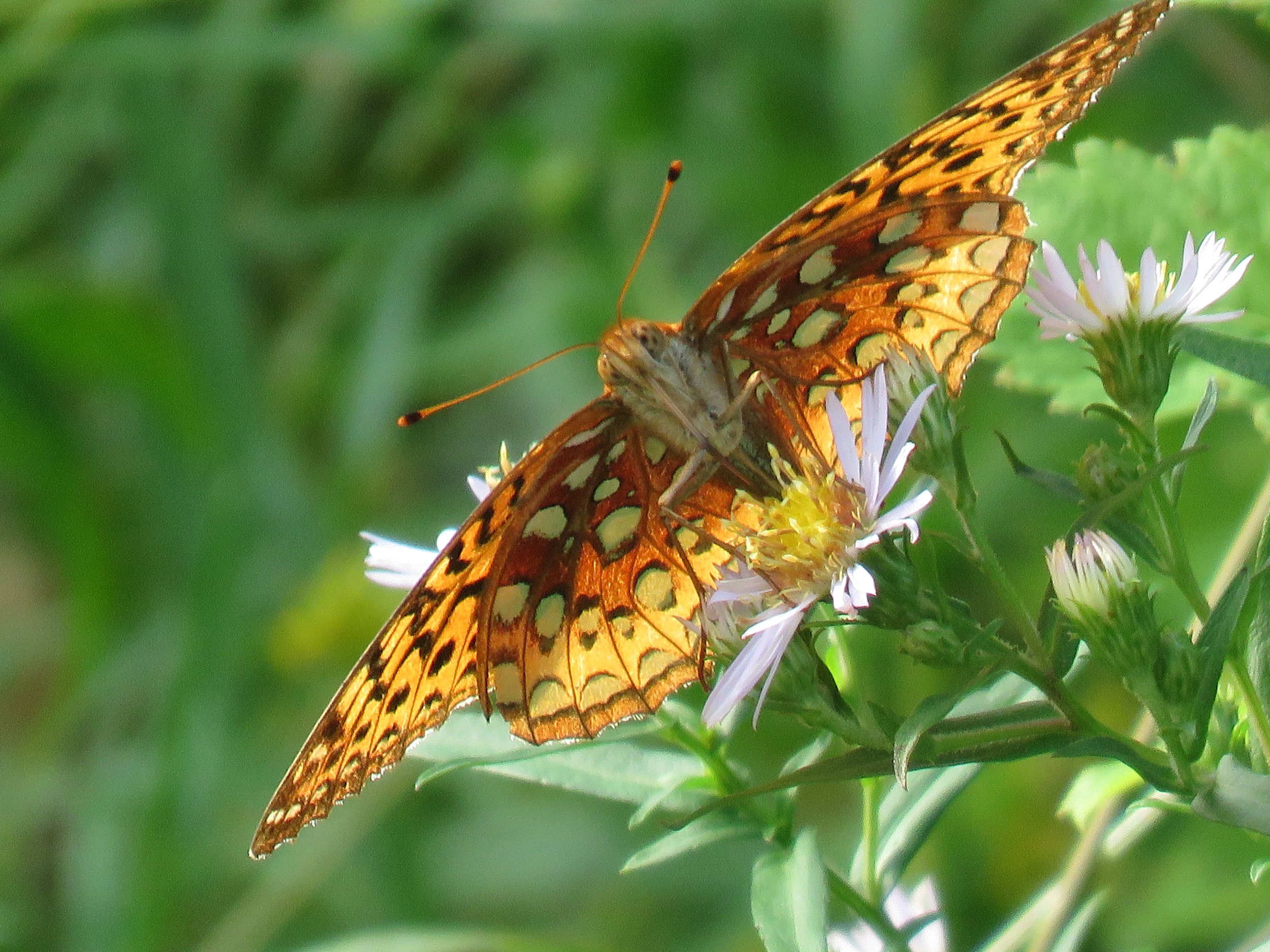Phenological Phacts and Photos w/ Carl Martland / September 2022
Bees, Blossoms, and Butterflies
Phenology – “a branch of science concerned with the relationship between climate and periodic biological phenomena (as the migration of birds or the flowering and fruiting of plants).”
Abundance of Asters and Goldenrods
As summer comes to a close, a couple of diverse families of flowers decide that it’s finally time to burst out in bloom. By late August in the North Country, temperatures are dropping into the 50s, not just at night, but even on some sunny afternoons. There’s not much time left, so asters and goldenrods have to make the most of it.
August 25, 2017, 65 degrees, mostly cloudy, seems like early autumn. White flat-topped asters and goldenrod are at their peak; Joe Pye Weed is past its peak; blue asters are coming along, and apples are reddening.
Unlike lady slippers, trillium and so many other flowers of early summer, asters and goldenrods cannot depend upon having a few fragrant or colorful blossoms that are carefully constructed to attract a particular insect. No, it is too late for such a refined strategy. Now, the fields are full, and sunlight is blocked by leaves of trees and shrubs before it can reach the ground where flowers first bloomed in May and June. So asters and goldenrods follow a simpler approach: produce hundreds and thousands of flowers on tall plants that can quickly fill up any open field or neglected roadside. Rather than creating a carefully designed flower, asters and goldenrods create mounds of color that cannot be missed, even at a distance of a hundred yards or more.
[1] Photos and text by Carl D. Martland, founding member of ACT, long-time resident of Sugar Hill, and author of Sugar Hill Days: What’s Happening in the Fields, Wetlands, and Forests of a Small New Hampshire Town on the Western Edge of the White Mountain. Quotations from his book and his journals indicate the dates of and the situations depicted in the photos.
Everyone Loves Asters
While asters and goldenrods are equally diverse, equally widespread, and equally attractive to a variety of insects, only asters are loved by almost everyone. Goldenrod suffers from a bad rap because of a mistaken notion that it causes hay fever. Not true! The real culprit is ragweed, a non-descript plant whose multitudinous, tiny, inconspicuous green (!) flowers carry the yellow pollen that causes misery for so many. Furthermore, while a mass of goldenrod is certainly visible at a distance, the individual flowers are too tiny to notice unless you, for some odd reason, enjoy carrying a magnifying glass and seeking detail where detail is pretty much irrelevant.
Asters not only produce a wall of color, they produce blossoms that are easily seen and enjoyed, whether they are an inch-and-a half-inch wide or merely a half-inch, whether they are white or variety of shades of blue, whether they cap a shrub-like jumble of intersecting plants or sit on top of a stalk that reaches up to our eye-level.
Bees, of course, are attracted to asters. If you watch a clump of asters on a sunny September day, you will very likely see a number of different types of bees flitting from flower to flower, entertaining you with a constant buzzing. Fans of the “Spelling Bee” are well acquainted with photos such as these.
September 13, 2019, 66 degrees, all sun!
September 26, 2018, 70 degrees, cloudy, some sprinkles, 130-3pm…Only purple asters in peak bloom; flat white-topped asters have gone by.
Magnets for Butterflies
No one needs to plan a long excursion to see asters. If you walk along any of our rural roads, you cannot fail to see asters at this time of the year, because they are just about the last, most abundant and most conspicuous of the many wildflowers that prosper in roadside drainage ditches. And it’s not just people out for a walk who are attracted to the asters, nor is it just the bees. Asters are particularly attractive to butterflies, so wherever you come across clumps of asters, you are apt to any of a variety of butterflies, including monarchs, our largest and most famous butterfly.
September 3, 2019, 1145, 64 degrees, 4pm. I went out again. It was now mostly sunny and absolutely calm, so that the pond was a mirror, great conditions for what were the best butterflies of the year, and perhaps of our 22 years. At least four monarchs were on asters at the far end of the dam, two or three at our end, and four or more on Joe Pye Hill, which adds up to more than a dozen around the pond.
Fritillaries form another colorful family of large butterflies that are attracted to asters. The most likely species to be found in our area are, in decreasing order of size, the great spangled fritillary, the Atlantis fritillary, and the Aphrodite fritillary. Viewed from above, each of these species has the same tawny orange/brown colors broken by black veins and spots, making it easy to identify a butterfly as a fritillary, even if it is difficult to get the close view necessary to figure out the species. Fortunately for us, they may pose long enough on an aster for you to take a photo sufficient to estimate their size. In the two photos of fritillaries, you can see that the Atlantis is much larger relative to the aster blossoms than the Aphrodite.
September 7, 2017. This view from below shows the markings that identify this as an Aphrodite fritillary.
September 1, 2019. The black border on its wings identifies this as an Atlantic Fritillary.
Fritillaries are seldom seen after the first week of September, but white admirals and clouded sulphurs will still be around for another week or so. White Admirals are readily recognized because of the broad white stripes on their upper wings, and they land frequently on flowers or on the ground. If they land on an aster, you have a chance to see the underside of their surprisingly colorful wings.
September 3, 2019. White admiral on New England asters.
September 12, 2018. White admiral on flat, white-topped asters.
Cloudy sulphurs are one of the most commonly seen butterflies in late summer. Their size and color make them easily identified as they fly from flower to flower across a meadow – but they seem unwilling to stop for more than a second or two. My guidebook describes the upper side of the male’s wings as “clear yellow with solid black outer margins.” Very nice – but try to see that black margin as these critters cruise about a meadow or pose with their wings closed, thereby usually concealing what really is a beautiful border. My guidebook also says that the sulphur family “may be responsible for the name ‘butterfly’, but I prefer to suspect some early adept at what became Cockney rhyming slang to have come up with this name after watching so many of them “flutter by” as he enjoyed an afternoon in an English garden with a fine border of asters.
September 13, 2018, 75 degrees, partly cloudy, beautiful. I finally managed to get a photo showing the black margin of a clouded sulphur that rested a few seconds on some asters.
Asters will persist through the end of summer, and they will continue to attract the few butterflies that remain in the area. I only have photos of a few butterflies that were taken in late September or October, and one of them was a Milbert’s tortoiseshell sitting on a New York aster, the last of the aster family still in bloom.
October 12, 2015, 65 degrees. A glorious fall day, sunny with high cirrus clouds, and a nice breeze from time to time…After lunch, I grabbed my camera, because I thought I saw a red admiral on the New York asters by the front porch. After examining my photos, I realized it was a Milbert’s tortoiseshell – a lifer for me (although my friend Tony later told me he once took a picture of one in our front yard).
Much as I hate to say what is very difficult for a life-long Red Sox fan, I have to admit that the blossoms of the New York aster are larger, deeper purple, and more attractive than the similar, but definitely second-place New England aster. At least I can say that the beauty of the New England aster is much closer to that of the New York aster than the success of our New England baseball team is this year to that of that unnamed team in New York. On the other hand, the Red Sox have from time to time bested the Yankees, whereas the New England asters will always be a few games behind.









